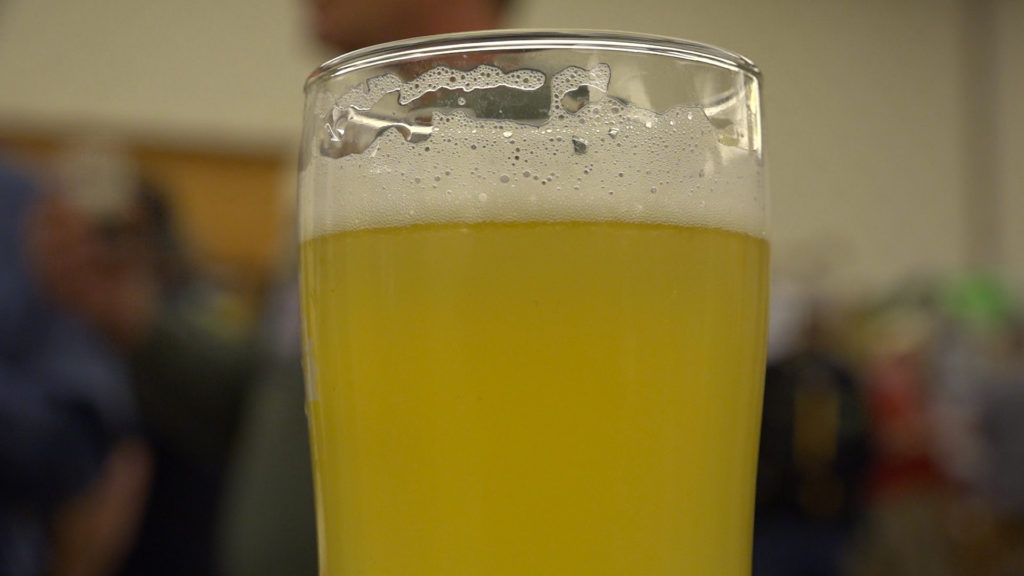
Recipe and information below provided by Alvaro Reyes, member of the Vanbrewers homebrew club in Vancouver, BC, Canada. Huge thanks to Alvaro for sharing this information and for hooking up the wonderful homebrew at Pacific Northwest Homebrewer Conference 2017.
* * *
A Pisco Sour is a mixed drink which uses Pisco, a grape brandy whose origins are hotly contested between Peru and Chile. In Peru, Pisco is un-oaked, and I try to get my hands on un-oaked stuff. A Pisco Sour cocktail is made by mixing 2 oz pisco with 1 oz lemon/lime juice, a bit of simple sugar, an egg white, and shaken till frothy. The concept was to make a beer that tasted like a Pisco Sour. I’ve won a few medals with this beer. On one scoresheet a BJCP judge from Saskatoon asked for the recipe. He made it, and won a best of show with it!
Numbers: OG 1.048, FG 1.012, ABV ended up calculated at ~6% (as it was spiked with hard liquor), minimal IBU, let’s say 0 to 5 IBU.
Prep:
Usually I’m lazy and I just rinse my kettle, but prior to brewing I did a hot PBW soak to get it nice and clean. I have had one kettle sour where I got THP (cheerios off flavour) probably due to some weird bacteria due to cleaning/sanitation issues.
Souring Bacteria:
I have had really good results with lacto. plantarum. It gives a clean lemony flavour, and that’s the character I wanted to mimic the lemon/lime flavours in the Pisco Sour. Prior to brewing, I made 1 L starter wort, and added 3 x Swanson’s Lactobacillus Plantarum probiotic pills. I kept the starter warm for about 2-3 days, by keeping it in my oven with just the light on. Target was to keep around 30C (86F) but it wasn’t super precise.
Grist:
Here I wanted to tone down the crackery pils malt flavours with some 2-row which would provide a bit more neutral sweetness. My efficiency is about 65% on my system.
- 2.7 kg (6 lbs) 2-Row
- 2.7 kg (6 lbs) Best Malz Pils
- In previous batches I have added 0.2 kg (0.5 lbs) acidulated malt. It’s optional.
Mash:
I calculated the volume so that my pre-boil volume was only just a shade over 6 gallons, as I was only going to boil for a short amount of time. Single infusion mash at around 66-67C (150-152F) for 1 hr
Kettle Souring Process:
Sparged and collected wort into the kettle. I brought the wort to a boil to kill off any bacteria that might have lived on my equipment, then chilled to 43.4C (110F). I inoculated with the lacto plantarum that I had grown up. Checked pH, added lactic acid to get down to pH of 4.5. That’s the magic number supposedly to make sure that nasty wild yeast/mold don’t grow. I put plastic wrap over the kettle, then the lid, and wrapped it with sleeping bags. Over the next 20 hours I would check on the temperature, and if it dropped to about 32C (90F), I would take off the blankets and fire up the burner on low heat until it hit 43C (110F). I only had to do this a couple of times.
Boil:
After the ~20 hours of kettle souring, the wort smelled nice and lemony and clean. In the batches I have made, a moderate pH of around 3.7-3.8 I found works best. You can make it more sour if you want by letting it go longer. Added 57 g (2 oz) of Hallertau Blanc hops, and boiled for 1 minute. The idea was to get some of that white wine character which comes with those hops. I know that Nelson Sauvin has some of the same character, but it’s way more pungent. You could try Nelson, but maybe a smaller amount. The no-boil method was done to keep some of the raw bread dough flavours that come with a no boil or short boil kettle sour. This
was to mimic the raw egg white protein flavours that are in a Pisco Sour
Chill:
- Chilled down to about 16-18C (61-64F)
Fermentation:
Here I like to use a kolsch/alt strain which brings out more white wine type flavours. My last batch I was super happy with Imperial Yeast G03 Dieter. Make a starter, or buy a few packages. Pitch rate should be lager pitch rate, as sour wort is hard on yeast. Ferment at around 16-18C (61-62F). After it was at terminal gravity, I let it sit for another week or so, so let’s say we were 2 weeks in. Dry hopped with 43 g (1.5 oz) of Hallertau Blanc for 3 days.
Packaging:
Into the keg I added 3/4 of a 700 mL (26 oz) bottle, or about 575 mL (18 oz) of Miguel Torres Pisco el Gobernador. Depending on where you are, it may be tough to get Pisco. I have tried a Peruvian Pisco in the past as well, that had nice aromatic notes it was Pisco Campo de Encanto. If you can get your hands on more special stuff, go for it!
Serving:
I just learned the real trick is to serve out of a creamer faucet. I don’t have nitro, just the creamer adaptor, but it does give a nice frothy, creamy head, which brings out some of those aromatics just like the cocktail.
There you go!
